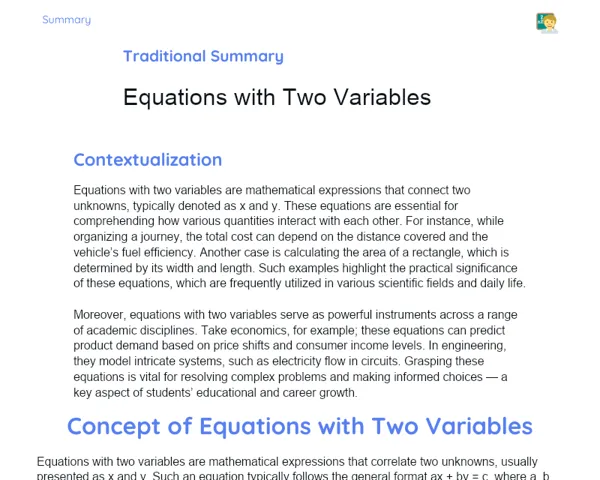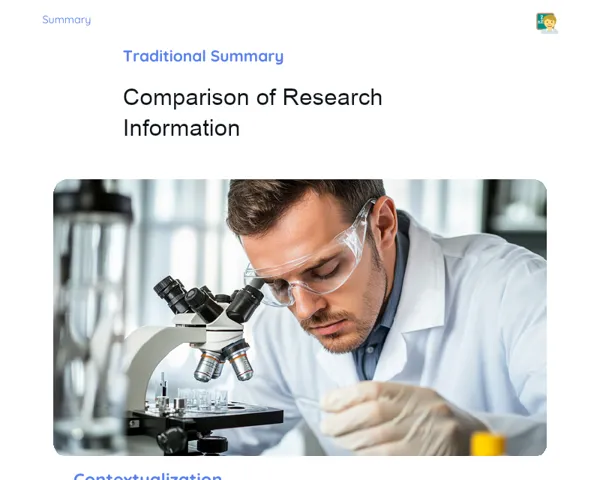Socioemotional Summary Conclusion
Goals
1. Hone the skill to solve logarithmic inequalities by understanding their inherent properties and applying specific mathematical techniques.
2. Enhance your ability to identify and interpret scenarios involving logarithmic inequalities through hands-on examples and practical exercises.
Contextualization
Did you know that in our day-to-day life, logarithmic inequalities can be used to solve challenging financial problems – like estimating how long it will take for an investment to double? Learning to work through these inequalities not only sharpens your math skills but also boosts your critical and logical thinking, skills that prove very handy in everyday situations!
Exercising Your Knowledge
Definition of Logarithm
Simply put, a logarithm tells you the power to which a fixed base must be raised to obtain a specific number. For instance, in the expression log₂8 = 3, the 3 means that 2 raised to the power 3 equals 8. This concept is fundamental in understanding how logarithms operate and how they can be manipulated in different mathematical contexts.
-
Relationship with Exponents: Logarithms serve as the inverse of exponents. If b raised to the power y equals x (b^y = x), then log_b(x) equals y.
-
Common Bases: While bases such as 10 (common logarithm) and e (natural logarithm) are frequently used, technically any positive number can be a base.
-
Exponential Nature: Grasping logarithms naturally leads to a better understanding of exponential functions, which are pivotal in various scientific and financial disciplines.
Properties of Logarithms
The properties of logarithms are a set of handy rules that make it easier to manipulate logarithmic expressions. These rules – including those for combining, dividing, and changing the base – simplify complex inequalities considerably. Being comfortable with these properties greatly improves your problem-solving efficiency and overall understanding of the mathematical relationships involved.
-
Sum Property: logₐ(bc) = logₐb + logₐc, which helps in simplifying the product of numbers inside the logarithm.
-
Subtraction Property: logₐ(b/c) = logₐb - logₐc, ideal for breaking down divisions within logarithms.
-
Change of Base: log_b(a) = log_c(a) / log_c(b), a useful trick to convert logarithms into a base that's more convenient for calculations.
Solving Logarithmic Inequalities
To solve logarithmic inequalities, one typically converts them into an exponential form and then proceeds with solving the resulting inequality. This process makes ample use of the properties of logarithms and requires deft manipulation of mathematical expressions. Mastering this technique is not only beneficial for handling academic problems but also sharpens your analytical and logical skills, which are applicable to many real-life situations.
-
Isolating the Logarithm: Begin by isolating the logarithmic expression as the first essential step.
-
Conversion to Exponential: Transform the logarithmic inequality into its exponential form to simplify the problem.
-
Existence Conditions: Ensure that the solutions you obtain satisfy the necessary conditions for logarithms to exist – this confirms the validity of your answer.
Key Terms
-
Logarithm: The exponent to which a base must be raised to produce a given number.
-
Logarithmic Inequality: An inequality that involves logarithmic expressions.
-
Change of Base: A property that permits the conversion of logarithms from one base to another.
For Reflection
-
How can practicing mindfulness help you manage stress when dealing with challenging math problems?
-
In what practical ways might the ability to solve logarithmic inequalities prove useful outside the classroom?
-
What have you discovered about your own emotions while collaborating with peers on math problems, and how might these insights help in other areas of life?
Important Conclusions
-
Logarithmic inequalities are powerful tools in mathematics that help us tackle complex problems, such as forecasting the growth of financial investments.
-
Mastering these inequalities not only bolsters your mathematical understanding but also builds critical and logical thinking skills that are applicable to everyday challenges.
-
Engaging in group activities and incorporating mindfulness in classes can lead to improved academic performance as well as better emotional balance.
Impacts on Society
Logarithmic inequalities have a substantial impact both in academics and practical life, especially in fields like finance and science. For example, grasping how investments grow over time can be the deciding factor between a wise financial move and an ill-informed one. This is particularly relevant in our context, where effective money management is essential for long-term stability. Moreover, the critical thinking and problem-solving skills developed through studying these inequalities are highly transferable to a wide range of professional scenarios. On a personal level, being able to crack complex problems helps boost confidence and reduce anxiety in future challenges.
Dealing with Emotions
To better manage your emotions while tackling logarithmic inequalities and their practical applications, try using the RULER method. Start by Recognizing your feelings when faced with a difficult math problem—it could be anxiety, frustration or even curiosity. Next, Understand the root cause of these emotions—whether it's due to the problem's complexity or the pressure of time. Make sure to Name these feelings accurately. Then, Express your emotions appropriately, perhaps by discussing them with a friend or jotting them down. Finally, regulate these emotions using deep breathing exercises or other mindfulness techniques you’ve learned in class.
Study Tips
-
Review the fundamental properties of logarithms and maintain detailed notes. Using different colours to emphasise key rules and examples can be very helpful.
-
Set aside at least 20 minutes daily for practice. Regularly tackling different types of logarithmic inequalities will build your proficiency over time.
-
Consider forming a study group. Discussing problems with peers can not only enhance learning but also make the process more enjoyable and interactive.



